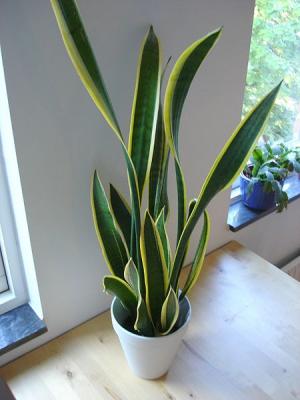Snake Plant

Sansevieria trifasciata 'Magic Sword', also known as the snake plant and mother-in-law's tongue is an evergreen herbaceous perennial plant forming dense stands that spreads by way of its creeping rhizome, which can be found either above or below ground. Named snake plant for the way the leaves twist and mother-in-law's tongue for their sharp blade like appearance, the leaves grow vertically from a basal rosette. Mature leaves are dark green with light gray-green cross-banding and usually range between 27–36 in long and 2–2.5 in wide. The plant is mildly toxic to pets as it does contain saponins; natural chemicals produced by the plant to protect it from insects, microbes and fungi. The level of toxin, however, is relatively low and the consequences for a pet that ingests the plant are typically limited to gastrointestinal upset. The Department of Horticultural Science for the University of North Carolina lists Sansevieria trifasciata as a plant of “LOW TOXICITY IF EATEN”; additionally noting “SKIN IRRITATION MINOR, OR LASTING ONLY FOR A FEW MINUTES. This does not mean that pets cannot be affected, only that the overall lethality of the plant is on the low side for all species. Further decreasing the likelihood of a potentially life threatening intoxication as a result of ingesting Sansevieria trifasciata is the fact that the saponins give the plant a very bitter taste, making it relatively non palatable. Thus it is wholly unlikely that a pet would or could tolerate eating a massive enough amount of the plant to suffer a life threatening toxicosis.
Avoid further ingestion of the plant and consult a veterinarian. Treatment is going to be largely symptomatic and supportive. If the ingestion was recent remove any existing plant matter from the mouth and if vomiting does not occur it may be induced by giving a teaspoon or less (size dependent) of 3% hydrogen peroxide orally. The pet will more than likely start vomiting on their own without the help, as their body tries to expel this non digestible material. Ensure the pet gets plenty of fluids to avoid possible dehydration caused by diarrhea. To alleviate the gastrointestinal upset and diarrhea Kapectolin may be given at a dose rate of 1 to 2 ml/kg four times a day. Kapectolin provides a coating action that protects the stomach lining. Sucralfate may also be used as for gastrointestinal irritation as it reacts with the acids in the stomach to form a paste-like material capable of acting as a barrier between the stomach and its contents. Sucralfate is typically given to dogs weighing more the 60lbs: 1g every 6 to 8 hours; for dogs under 60 lbs: 0.5g every 6 to 8 hours; Cats: 0.25g every 8 to 12 hours to reduce irritation of the stomach and intestines. The prognosis is good and pets are expected to make a full recovery in 1 to 2 days.




